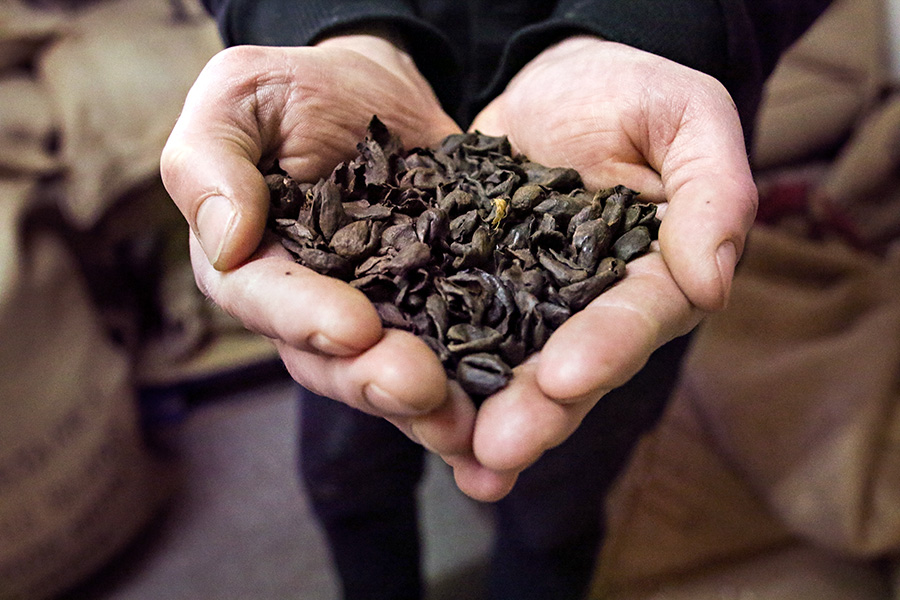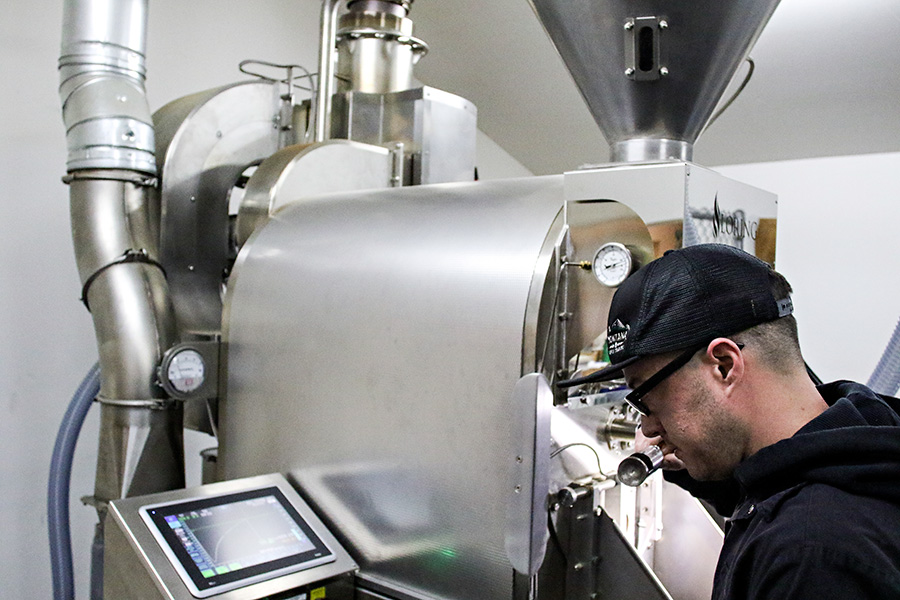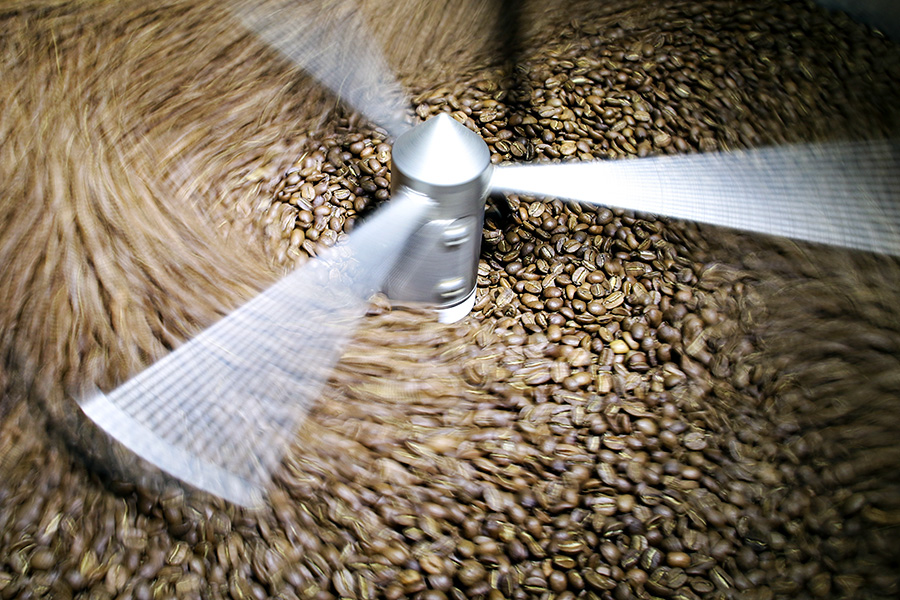Art of the Roast
Perfecting their own precise processes, Flathead Valley coffee roasters transform the green seeds of coffee berries grown thousands of miles away into beloved java blends
By Myers Reece
Simply put, a coffee bean is a fruit seed — a cherry pit of sorts — but it’s also clearly so much more. It’s the source of a liquid that is a morning necessity for many, an anytime treat for many others, an axis upon which business meetings and social gatherings revolve, an industry and a lifestyle, a culture unto its own.
The red berries that grow on plants of the coffea genus, namely in Latin America, Africa and Southeast Asia, are called coffee cherries. Many thousands of pounds of these cherries’ seeds annually make their way to Northwest Montana, where there is a growing roster of roasters equipped to transform the green beans into the dark morsels of caffeinated goodness that we love, which means Flathead java enthusiasts are afforded wide access to coffee roasted locally mere hours or days before consumption.
Montana Coffee Traders, Fieldheads Coffee Company and Colter Coffee Roasting have established roasting businesses in the valley, turning burlap bags of green coffee beans from around the world into light, medium and dark roasts for distribution at vendors and enjoyment at coffee shops and in homes. Waxwing Coffee Roasters, a small artisan operation, has also started up.
Montana Coffee Traders is the oldest of the bunch, dating back to 1981 when founder R.C. Beall started roasting his first batches in an old farmhouse in Whitefish. In the years since, Beall’s business has grown into a community fixture with coffee shops in Whitefish, Kalispell and Columbia Falls, in addition to its roastery just south of Whitefish on U.S. Highway 93.
Today, Zach Farnes heads up roasting operations for Montana Coffee Traders. He got a new toy last year: a 4.5-ton energy-efficient Loring air roaster with digital capabilities far beyond those of his two existing primary roasters, both of which are Sivetz fluid bed air roasters, rather than drum roasters, and are still in daily operation alongside the Loring.
Farnes and his crew now churn out anywhere between 30,000 and 50,000 pounds of roasted beans per month, destined for grocery store shelves, coffee shops and drive-through stands across Montana, as well as throughout the world via mail order. Farnes, who has been head roastmaster for a year and a half, views his job as a perpetual science experiment that never loses his interest.

Providing a demonstration to visitors, Farnes bounced between the machines, describing the differences, ranging from subtle to significant, between varying roasting temperatures and times. In the heat, the beans turn from green to yellow and then start cracking at 380 to 395 degrees.
“After that, the flavors start to develop,” Farnes said, adding that the beans shed their skin, producing a byproduct called “chaff.”
End temperatures depend on the bean and desired roast level — light, medium, dark, of varying shades of brown and black — but are all above 400, with each degree and increments of seconds altering the character. Pre-roasting factors impact the final product as well, including the bean’s individual traits and flavor profiles, its origin surroundings and method of processing.
Rattling off adjectives, Farnes pulled beans out of the Loring throughout the process to smell them and discern emerging flavors and aromas.
“It’s a lot of fun,” he said.
Lindsay Macdonald was a roaster at Montana Coffee Traders before he started his own business, Colter Coffee Roasting, in 2003. Macdonald ran the roasting operation and downtown Kalispell coffee shop until 2015, when he sold the roastery to City Brew and the shop to an independent owner, who licenses the Colter name.
Macdonald continues to head up roasting for City Brew in Kalispell, producing roughly 90 percent of his product for the Colter brand and 10 percent for the City Brew brand. City Brew also has a roastery in Billings.
Macdonald runs a Diedrich drum roaster with a 100-pound capacity out of City Brew’s north Kalispell location, where there’s also a coffee shop, near the Blue Cow Car Wash. Before moving there in March 2017, Macdonald operated in an Evergreen facility.
Colter’s coffee is found in grocery stores, coffee shops and restaurants across Montana, as well as online. It specializes in espresso, as Macdonald has developed eight espresso blends over the years. Macdonald said selling the business has allowed him to refocus exclusively on his love of roasting.
“It’s almost like we’re a lab here,” he said. “We do a lot of profile roasting, evaluation of the coffee itself, the effect of the roasting on the coffee. It’s really a fun experience getting back to your roots of why you got into the business in the first place.”

Ben Storest and his wife purchased Fieldheads Coffee Company from Peggy Ennenga and started roasting coffee in 2012 out of a shop in Creston. Ennenga had launched Fieldheads’ roasting business in 2003 in Kalispell before moving it to Creston.
Storest, a carpenter, was looking for an undertaking he could share with his two daughters and was drawn to roasting. He’s thankful that Ennenga spent time showing him the ropes, as the trade proved far more difficult than he had anticipated.
“Once I got my head in the game, I was like, ‘Wow, there’s a lot to learn and do, a lot to pay attention to,’” Storest said. “I’m still always educating myself. It’s fun.”
Storest continued working as a carpenter while he roasted on the side. Not even a background in strenuous manual labor, however, prepared him for tossing around 150-pound bags of coffee beans all day.
“It’s very labor intensive,” he said. “You feel it by the end of the day.”
The Storests moved to Bigfork and opened a retail coffee shop downtown last year. Storest specializes in small-batch, artisan roasting, using a Diedrich drum roaster with a 30-pound capacity. Like other local roasters, Storest gets beans from all over the world.
“We have single origins from every main coffee region: Indonesia, Africa and the Americas,” he said.
Propelled by quality blends that have attracted high ratings from national coffee reviewers, Fieldheads has doubled its sales since the Storests started, and it ships products to coffee shops throughout the Flathead and elsewhere in Montana, as well as a few local grocery stores. Glacier Perks in Lakeside and Amazing Crepes in Whitefish are among Fieldheads’ notable Flathead vendors.
Storest enjoys experimenting, including a popular whiskey cask-aged espresso. The shop boasts blends not even found on Fieldheads’ website.
“I’m always looking to improve,” Storest said. “There’s always room to up the game.”
Pete Milne and Levi Hoch started Waxwing Coffee Roasters last year and are currently working out of a garage with an eye toward securing a location in Kalispell. Waxwing has been selling its single-origin blends through its website and social media, as well as word of mouth. Ceres Bakery in Kalispell and Azul Coffee Bar, which operates out of Uptown Hearth in Columbia Falls, have carried Waxwing’s coffees as well.
Waxwing’s emergence adds to the Flathead’s formidable lineup of high-quality roasters, varying in scope and consumer reach. Farnes, of Montana Coffee Traders, says it’s an encouraging and natural outgrowth of Flathead’s increasingly thriving coffee scene, which shows no signs of slowing down. The way Farnes sees it, the more the merrier.
“The coffee culture is growing here, and customers are getting more educated and know what they want,” he said. “It’s super cool to see.”